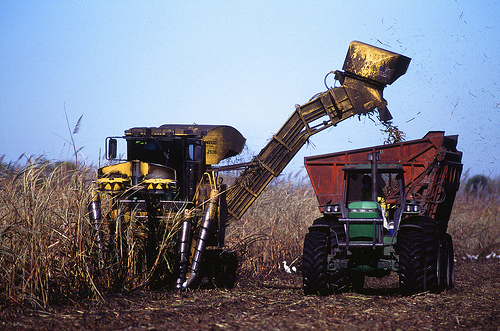Agriculture’s Role in Ecosystem Services

Harvesting sugarcane in south Florida, ARS scientists at the Sugarcane Production Research Unit are identifying research to help sustain both agriculture and natural Everglades ecosystems.
This post is part of the Science Tuesday feature series on the USDA blog. Check back each week as we showcase stories and news from USDA’s rich science and research portfolio.
Most of us accept that some services—such as waste water treatment and emergency response, for example—have an economic value. As citizens, we decide to support these services for our safety, security and comfort. And yet there are many other functions going on every day, all around the world, that are not directly supported but still enable our planet to maintain favorable living conditions for all living creatures—functions like bees pollinating our crops, forests absorbing excess carbon dioxide, or dung beetles breaking down animal wastes.
These functions, known as ecosystem services, include all the jobs performed by the components of an ecosystem, coming from biotic components like plants and insects, to abiotic components, such as the soil and wind. Ecosystem services include things like pollination (approximately one third of the human diet comes from insect pollinated plants), water filtration (wetlands protect water quality by trapping sediments and retaining pollutants such as heavy metals), energy (7 percent of US power comes from hydroelectric plants), and tourism (nature-based tourism or ecotourism is predicted to grow to 25 percent of the world travel market by 2012). And these services, without most of us even knowing it, add substantially to our economy. For example, the value of insect pollination has been estimated at up to $15 billion in the United States annually, and ecotourism has a worldwide value of approximately $473 billion per year.
As a growing world population slowly pushes ecosystem services to new limits, the issue that more and more scientists and policymakers are trying to confront is how to value ecosystem services. Because we don’t directly support many of these services, we may undervalue them. Yet ecosystem services are very valuable to agriculture, which is why USDA scientists and policy makers are increasingly working to understand ecosystem services and find ways to elevate our understanding of their importance and value them at the same time.
Many USDA agencies have active research programs in the area of ecosystem services. For example, ERS is investigating the economics of ecosystem services and design issues for ecosystem service markets, including the use of greenhouse gas offsets and interactions with conservation programs. NIFA has several programs that address environmental markets, including a program on enhancing ecosystem services from agricultural lands and the National Integrated Water Quality Program, whose goal is to contribute to the improvement of the quality of our nation’s surface water and groundwater resources through research, education, and extension activities. And ARS has a Water Availability & Watershed Management National Program which addresses the highest priorities for agricultural water management including erosion, sedimentation, and water quality protection, and improving watershed management and ecosystem services in agricultural landscapes.
Agriculture plays a major role in protecting ecosystem services, and in turn can reap great benefits from services that are functioning properly. Given that, it’s encouraging to know that USDA scientists and policy makers will continue to do their part to ensure that America’s ecosystems are able to provide the services we all need long into the future.
